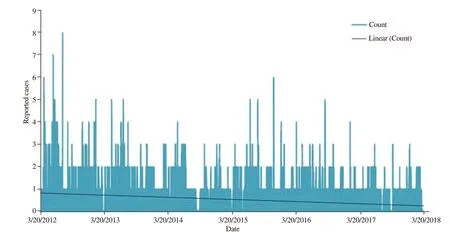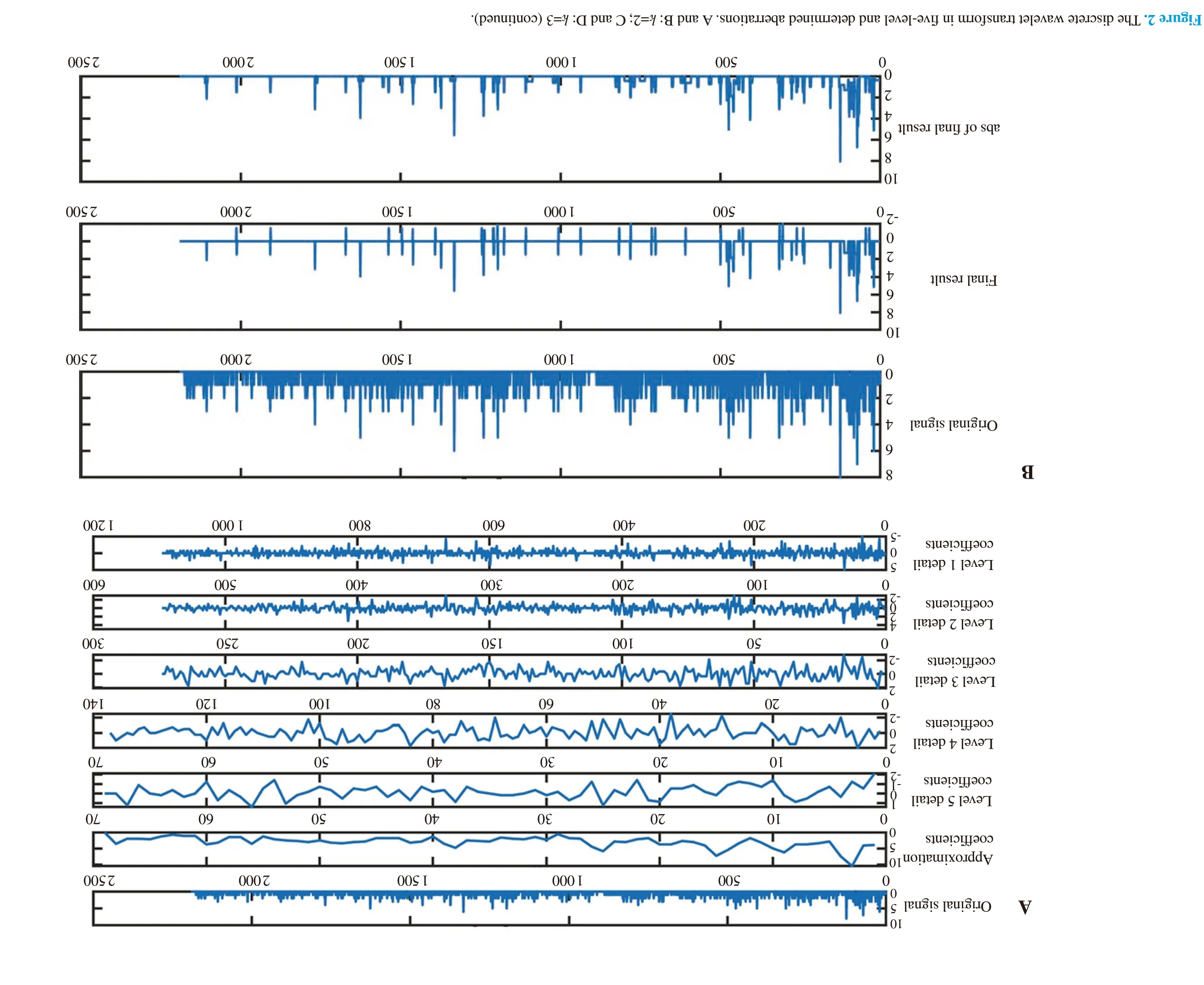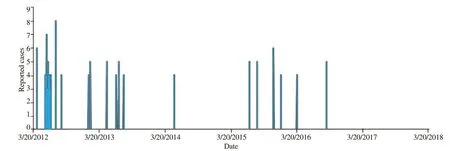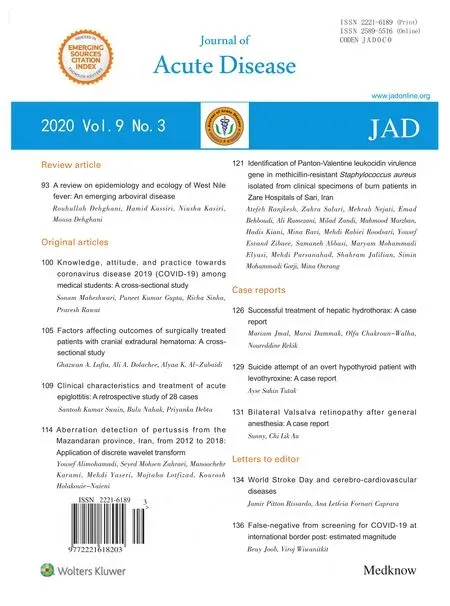Aberration detection of pertussis from the Mazandaran province, Iran, from 2012 to 2018: Application of discrete wavelet transform
Yousef Alimohamadi, Seyed Mohsen Zahraei, Manoochehr Karami, Mehdi Yaseri, Mojtaba Lotfizad, Kourosh Holakouie-Naieni✉
1Department of Epidemiology and Biostatistics, School of Public Health, Tehran University of Medical Sciences, Tehran, Iran
2Center for Communicable Diseases Control, Ministry of Health and Medical Education, Tehran, Iran
3Research Center for Health Sciences, Hamadan University of Medical Sciences, Hamadan, Iran
4School of Electrical & Computer Engineering, Tarbiat Modares University, Tehran, Iran
ABSTRACT
KEYWORDS: Aberration detection; Pertussis; Mazandaran; Iran; Discrete wavelet transform
1. Introduction
The surveillance of communicable diseases is the main responsibility of the public health sectors, which is very important for predicting the development of infectious diseases at the national and international levels[1]. Despite the development of many prevention and control programs against infectious diseases, they remain one of the main public health problems in the world particularly in developing counties[2]. Infectious diseases can be easily transmitted from infected persons to suspected persons and cause epidemics and outbreaks at the national or international level due to their contagious nature[3]. The main object of the surveillance system is early detection and warning of the aberrations of the infectious diseases by monitoring the reported cases. Early detection of the aberrations could subdue the spread of infectious diseases and decrease hospital admission and mortality[4,5]. One of the main methods of early detection of infectious diseases is to establish a syndromic surveillance system that plays a great role in the early detection of the outbreak and bioterrorism attack through detecting aberrations using statistical methods such as cumulative sum, exponentially weighted moving average (EWMA) and time series models[4,6-8].
In spite of the setting of immunization programs in many countries, pertussis remains one of the main public health problems in the world[9-12]. Roughly, 20-40 million pertussis cases are reported globally per year[13]. Iran is among the countries that have achieved high vaccine coverage against pertussis. However, considerable suspected and confirmed cases of pertussis have been reported annually from different parts of Iran[10]. According to the registration data released by the Iranian Ministry of Health, Mazandaran is one of the areas with a high number of reported suspected cases of pertussis. Thus, monitoring of reported cases can play an important role in the definition of alarm threshold level and detection of aberrations from the normal trend in the province.
Although discrete wavelet transform (DWT) is very helpful in aberration detection[14], the appliance of DWT in the surveillance system is very rare, and similar studies are few both in Iran and other countries. Considering the importance of this method in aberration detection and the lack of relevant literature, the current study aimed to define the level of alarm threshold for pertussis aberrations and to detect the aberrations by the DWT method in reported suspected cases of pertussis in Mazandaran provinces, North of Iran.
2. Materials and methods
2.1. Ethics approval
This study was approved by the Ethical Committee of Tehran University of Medical Sciences with ID: IR.TUMS.SPH.REC.1397.276.
2.2. Data collection
The included cases were composed of the suspected pertussis patients who came form Mazandaran province and registered in the Center for Disease Control and Prevention from 20 March 2012 to 20 March 2018. Data used in this study were registered into national databases on a daily basis. In this study, a suspected case of pertussis refers to a person who has a cough for more than or equal to two weeks and presents in an outbreak setting for any duration. In addition to the above definition, suspected pertussis case is defined as a person diagnosed with at least one of the following symptoms: paroxysms (fits) of coughing, inspiratory whooping, post-tussive vomiting, or vomiting without other apparent cause and apnea (only in <1 year of age). All suspected cases of pertussis that were referred to health homes or hospitals were registered in the Ministry of Health online portal system after confirmed by physicians. In addition, nasopharyngeal swabs were taken from all suspected cases and referred to the Iranian National Reference Laboratory (Pasteur Institute) within 72 h for laboratory confirmation[10].
2.3. Aberration detection
DWT and Shewhart control chart was used to detect the aberrations, and the Haar wavelet was used to perform DWT. Haar wavelet is the simplest type of wavelet function. The results of wavelet decomposition using Haar wavelet through approximation and detail coefficients methods at j level were calculated as:(j): (Sn+1+Sn)/2 (approximation) and (j): (Sn+1-Sn)/2 (detail).
The original time series were decomposed into several approximations and details coefficients by using the above functions. All the details coefficients and finest approximation were monitored by the Shewhart control chart after decomposition. The points between the upper and lower control limit of the Shewhart chart were set at zero, and the points outside the limit range retained their values. After time series decomposition monitored using the Shewhart control chart, the original signal reconstructed by all details and the final approximation coefficient. The reconstructed signals were monitored by the Shewhart control chart for the detection of aberrations from the normal trend. Considering the length and frequency of the original signal, the five-level decomposition method was used to determine the overall alarm threshold, whereas two and three decomposition levels were used to determine the seasonal alarm threshold.
2.4. Shewhart control chart
The Shewhart control chart is a statistical process control chart. The level of alarm threshold or upper control limit was calculated as follows:
Upper control limit (UCL): µ+ kδ
Where µ is the mean of reported cases in the time-series data and δ is the standard deviation of the reported cases; k is the desired confidence interval. In this study 2 (95%CI) and 3 (99%CI) were considered as k values to calculate UCL of reported cases. Whenever the numbers of reported suspected cases of pertussis in a day in Mazandaran province were more than determined UCL or level of the alarm threshold, it was considered as an alarm for outbreak or aberration from the normal trend. All analyses were performed using MATLAB software version 2018a and Excel 2010.
3. Results
3.1. Descriptive statistics
A total of 1 162 suspected cases of pertussis were registered in Mazandaran Province during the study period. Of the 1 162 suspected cases, 545 (46.9%) were male, with the median age of1.47 (0.22-9.56) years. The median age of males was 1.18 (0.21-8.24) years, while the female was 1.82 (0.21-10.75) years. The trend of reported suspected cases of pertussis during the study period showed a decline (Figure 1). The median number of reported cases was 0 (0-1) per day. Most of the reported cases were seen in spring, while the least was in winter.

Figure 1. The trend of reported suspected cases of pertussis from Mazandaran province from 2012 to 2018.
3.2. Aberration detection
Figure 2 depicts five-level decomposition of original time-series data, and monitored reconstructed time series which detected aberrations by considering the k=2 and k=3 for UCL of Shewhart control chart, respectively.
After performing the DWT in five-level and monitored the reconstructed signal, the level of final UCL in Shewhart control chart by considering k=2 was 1.28 case/d, whereas 1.34 case/d when k=3. It means that if the number of reported cases in the Mazandaran province was more than 2 case/d, it can be considered as an aberration of the normal trend. The total detected aberrations days by considering k=2 and 3 were 123 d and 57 d, respectively. Figure 3 and Figure 4 show aberration days according to different dates during the study period by considering k=2 and 3, respectively. According to these figures, most of the aberrations in Mazandaran province occurred during summer. The UCL or alarm threshold in the Shewhart control chart after 2 and 3 level decomposition according to the different seasons was shown in Table 1. The most defined UCLs were related to spring (>2 cases/d) and summer (>1 case/d) (Table 1).

Table 1. Determined upper control limit for daily reported suspected cases of pertussis from Mazandaran province from 2012 to 2018 (per day).
4. Discussion
Early detection of the outbreaks and aberrations through the surveillance system could play an important role in the prevention of infectious diseases. Moreover, defining the alarm threshold level and aberrations for infectious disease is important. However, there is limited information on the alarm threshold level and aberrations of pertussis in the Mazandaran province of Iran. Therefore, the current study aimed to define the level of alarm threshold and aberrations from the normal trend of reported suspected cases of pertussis in the Mazandaran provinces, Iran.
The current study revealed that most of the suspected cases of pertussis were females. This result is similar to another study[15]. The high proportion of pertussis among females may be due to the high susceptibility of the female gender to pertussis. Moreover, this difference between genders could be due to that more female cases were referred to the health centers than male cases. Pertussis can affect all age groups[16]. In the current study, the median age of suspected cases of pertussis was 1.47 (0.22-9.56) years. It means 50% of reported cases were older than 1.47 years, which indicates that the incidence of pertussis is increasing with ages due to the fact that immunity weakens overtime at older ages[17]. This finding is consistent with previous studies that indicated a higher incidence rate of pertussis in adults[18,19].
The level of Shewhart control chart after performing DWT by considering k=2 was 1.28 case/d, while 1.34 when k=3. This indicates that if the reported suspected cases of pertussis were more than 2 case/d, it can be considered as an aberration from the normal trend. The most defined UCL for suspected cases of pertussis in Mazandaran province were related to spring (>2 cases/d) and summer (>1 case/d). The higher level of alarm threshold in the mentioned seasons most probably is due to different factors such as more reported cases in these seasons. In addition, the determined UCL or alarm threshold is affected by the sensitivity of the surveillance system and higher sensitivity leads to higher reported cases and in turn to the highest alarm threshold level. Thus, this determined UCL could be changed over time through the variance of the sensitivity of the surveillance system.


Literature about the use of DWT in the outbreak and aberration detection is rare. As far as the author’s knowledge, there is rarely a similar study that reported aberration detection in the trend of infectious diseases using DWT in Iran. But there are some studies that applied other methods such as EWMA and cumulative sum[4,5,20,21], and there are some similar studies in other parts of the world. A study reported by Zhang et al. indicated that the wavelet transforms-based method can detect anomalies and aberrations faster than other methods, and it is not affected by the abnormal decreases in the number of cases or negative singularities[22]. Another study reported by Dillard et al. showed that wavelet transform-based methods have the highest ability to issue an early warning of outbreaks than other methods such as EWMA[23]. Therefore, it seems that the DWT-based method can be considered as an effective method in terms of aberration and outbreak detection.
The current study had some limitations. The first is no gold standard to evaluate the performance of our defined alarm threshold levels and aberrations. Therefore, a single method in determining the level of the outbreak threshold is not sufficient. The second limitation is related to the effect of the sensitivity of the surveillance system on the determined alarm threshold. The changes in the sensitivity of the surveillance system could affect the determined alarm threshold. Thus, it is recommended that the alarm threshold level should be determined periodically by using different methods. The third limitation of this study is the dataset used. The information related to confirmed cases of pertussis was incomplete, which could limit the quality of the determined alarm threshold. In spite of the mentioned limitations, the current study for the first time in Iran, it used the DWT method to define the level of alarm threshold of outbreaks and providing quality information on the current situation of pertussis and the level of alarm threshold of outbreaks in the study area. Understanding the level of alarm threshold of infectious diseases could be helpful in the timely detection of outbreaks which is very important in curbing the transmission of infection. Thus, the determined level of alarm threshold of pertussis in Mazandaran province could be helpful in the timely detection of aberrations by the surveillance system and the public health sectors. However, due to the variations in reported cases over time, the threshold level needs to be updated every few years.
Conflict of interest statement
The authors report no conflict of interest.

Figure 3. Aberrations days with considering k=2 in determine Shewhart upper control limit.

Figure 4. Aberrations days with considering k=3 in determine Shewhart upper control limit.
Acknowledgments
The authors would like to express their appreciation for the Iranian Ministry of Health and Center for Communicable Diseases Control for their constant support and collaboration. This article was extracted from the Ph.D. thesis by Yousef Alimohamadi and financially supported by Tehran University of Medical Sciences.
Authors’ contribution
Y.A.: Data analysis, interpretation of data and wrote the manuscript development; S.M.Z. contributed to the data analysis and the study concept and design, and provided supervision, data extractions and provided expert insight; M.K., M.Y. and M.L. contributed to the study design and the data analysis, the study quality evaluation, manuscript preparation, and K.H.N. provided supervision, data analysis, expert insight, and wrote the manuscript development. The authors read and approved the final manuscript.
 Journal of Acute Disease2020年3期
Journal of Acute Disease2020年3期
- Journal of Acute Disease的其它文章
- Bilateral Valsalva retinopathy after general anesthesia: A case report
- Suicide attempt of an overt hypothyroid patient with levothyroxine: A case report
- Successful treatment of hepatic hydrothorax: A case report
- Identification of Panton-Valentine leukocidin virulence gene in methicillinresistant Staphylococcus aureus isolated from clinical specimens of burn patients in Zare Hospitals of Sari, Iran
- Clinical characteristics and treatment of acute epiglottitis: A retrospective study of 28 cases
- Factors affecting outcomes of surgically treated patients with cranial extradural hematoma: A cross-sectional study
